List of cars with non-standard door designs
This is a list of cars with non-standard door designs, sorted by door type. These car models use passenger door designs other than the standard design, which is hinged at the front edge of the door, and swings away from the car horizontally and towards the front of the car.
List of non-standard door designs
The main types of non-standard door designs are:
- Butterfly – butterfly doors move via hinges along the A-pillar, on an axis not aligned vertically or horizontally to the vehicle or ground. A special type of butterfly door is a single door at the front of the car with the steering wheel attached.
- Canopy – roof, windshield, and sides are one unit that moves upward, forward, or sideways to provide access.
- Gullwing – (also called "falcon-wing") hinged to the roof at the top horizontal edge of the door, and open upward on a horizontal axis. Gullwing doors with a second hinge between door and moving roof panel are called falcon wing doors.
Similar to a Gull Wing door the Falcon wing door is a double hinged rear door on the Tesla Model X. The primary hinge is located along the midline of the roof, the second hinge is above the side window. This configuration has the advantage of allowing unobstructed access to the rear seats whilst also enabling the doors to open in a tight space because the door can initially open upwards before spreading outwards with a gap as small as 8-inches to adjacent vehicles.
- Scissors – rotate vertically at a fixed hinge at the front of the door, and open by rotating on a horizontal axis, perpendicular to the vehicle's length. Scissor doors that also move outward while rotating are called dihedral synchro-helix actuation doors.
- Sliding – mounted to or suspended from a track, and open by sliding horizontally alongside or into the vehicle sidewall, or open by sliding vertically into the vehicle sidewall or floor. Sliding doors that disappear into the floor horizontally are called rolling doors.
- Suicide – hinged on the rear end of the door-frame, and open horizontally towards the rear.
- Swan – opens outward like either a conventional door or a suicide door, but on an axis slightly tilted from vertical, or via articulation in the hinge to angle upward for better ground clearance
Some custom limousines have enlarged doors.
Scissor doors

Road-legal cars
- Arrinera Hussarya –
- Bugatti EB110
- BMW I8
- Dome Zero
- Ferrari LaFerrari Aperta (doors open up and outward at a slight angle) –
- Giottiline Ginko
- HTT Pléthore LC 750
- IFR Aspid
- Jimenez Novia (doors include part of the roof)
- Kepler Motion
- Lamborghini Aventador (doors open up and outward at a slight angle)
- Lamborghini Aventador J
- Lamborghini Centenario
- Lamborghini Countach
- Lamborghini Diablo
- Lamborghini Murciélago
- Lamborghini Reventón
- Lamborghini Veneno
- Lykan HyperSport –
- Mitsuoka Orochi
- Montecarlo Rascasse (similar doors to the Lamborghini Aventador)
- MTX Tatra V8 –
- Renault Twizy
- Spyker C8 Aileron, Spyker C8 Double and Spyker C8 Laviolette
- Spyker C8 Aileron Spyder and Spyker C8 Spyder
- Spyker C12 Zagato
- Tata Pixel
- Toroidion 1MW –
- Tushek T700
- Vaydor
- Vector M12
- Vector W8
Racing cars
Concept cars
- Alfa Romeo Carabo
- Alfa Romeo Brera Concept
- Alfa Romeo Pandion – Large suicide-scissor front doors
- Aston Martin AMV10
- Audi RS7 Concept
- Bertone Barchetta – Large suicide-scissor front doors
- Bozca Zest –
- Cadillac Cien
- Chery Ant
- Chevrolet Miray
- Chrysler Portofino – Front scissor doors, with rear suicide scissor doors
- Citroën C-Métisse – Front scissor doors, with rear scissor doors
- Citroën Survolt
- Citroën Zabrus
- Dodge ZEO concept (front scissor doors with suicide rear scissor doors)
- Ford Indigo – Large suicide-scissor front doors
- Giugiaro Ford Mustang
- Isuzu Como Concept
- Jaguar XJ220 Concept
- Kia Kue
- KTM E3W
- Land Rover Range Stormer
- Mazda Hakaze Concept
- Mercedes-Benz Aria Concept – Large conventional-scissor front doors, with large suicide-scissor rear doors
- Peugeot Quartz
- Peugeot Shine – Front scissor doors, with rear scissor doors
- Pininfarina Sintesi – Front scissor doors, with rear scissor doors
- Renault Alpine A110-50
- Renault Coupe Corbusier – Large suicide-scissor front doors
- Renault Laguna Coupe Concept
- Renault Zoom
- Spyker Silvestris V8
- Toyota Alessandro Volta
- Toyota Bionic+ – Large suicide-scissor front doors
- Toyota Concept-愛i--Front scissor doors with rear suicide scissor doors
- Vector WX-3
- Volkswagen W12 Nardó
- Volkswagen W12 Roadster
- Volkswagen W12 Syncró
- Zender Fact 4
Butterfly doors

Road-legal cars
- Alfa Romeo 33 Stradale
- BMW i8
- Devon GTX
- Donkervoort D8 GT
- Felino CB7
- Ferrari Enzo Ferrari
- Ferrari LaFerrari
- Ford GT (2nd generation)
- Gillet Vertigo
- GTA Spano (second generation only)
- Heinkel Kabine
- Joss JP1
- Joss JT1
- Isetta
- Laraki Fulgara
- Lotec Sirius
- Manta Montage
- Marussia B1
- McLaren 12C – Doors are not hinged at the roof, unlike most butterfly door designs
- McLaren 12C Spider – Similar doors to McLaren 12C
- McLaren 540C, McLaren 570GT and McLaren 570S
- McLaren 625C, McLaren 650S and McLaren 675LT
- McLaren 625C Spider and McLaren 650S Spider
- McLaren 720S
- McLaren F1 and McLaren F1 LM
- McLaren M6GT
- McLaren P1
- McLaren Senna
- Mercedes-AMG Project One
- Mercedes-Benz CLK GTR (Street Version)
- Mercedes-Benz CLK GTR Roadster
- Mercedes-Benz SLR McLaren
- Mercedes-Benz SLR McLaren Roadster
- Mercedes-Benz SLR McLaren Stirling Moss
- Mosler MT900
- Panoz Esperante GTR-1
- Porsche 911 GT1 Straßenversion
- Porsche 928 Strosek Ultra Wing
- Saleen S7 and Saleen S7 Twin Turbo
- Savage Rivale Roadyacht GTS – Conventional-butterfly front doors, with suicide-butterfly rear doors
- SIN R1
- SSC Aero
- SSC Tuatara
- SSC Ultimate Aero and SSC Ultimate Aero XT
- Stealth B6
- Toyota Sera
- Ultima Evolution
- Ultima GTR
- Ultima Mk. 3
- Ultima Sports
- Volkswagen XL1
Racing cars
A common door design on Group C, IMSA GTP cars of the 1980s and early 1990s and recently on Daytona Prototype and Le Mans Prototype cars, this list does not include cars categorized as such. This list only includes purpose built race cars.
Concept cars
- Alfa Romeo Diva
- Audi Avus quattro
- Audi Nanuk – Similar doors to the McLaren 12C, with panels extend from the top to the roof (similar to the Ford GT40)
- Bertone Mantide
- BMW i8 Concept
- BMW Vision EfficientDynamics – A concept electric car based on the production BMW i8 with butterfly doors
- Cadillac Urban Luxury Concept
- Citroën C-Métisse–Front butterfly doors, with rear suicide scissor doors
- Citroën GT
- Citroën Karin
- Ferrari P4/5 by Pininfarina
- Geely Tiger GT
- Great Wall Haval E
- HU-GO
- Hyundai HND-9
- Infiniti Concept Vision Gran Turismo
- Isuzu XU-1
- Italdesign Giugiaro Parcour
- Italdesign GTZERO –
- Kia Niro – Similar to butterfly doors, with panels extend from the roof to the top (similar to the Ford GT40)
- Lotus M250
- Mazda Furai
- Mazda Kiyora
- Mazda RX-500 – Butterfly front doors with gull-wing doors over the engine compartment
- Mazda Taiki
- McLaren SLR Stirling Moss
- Mercedes-Benz Vision SLR
- Renault Altica
- Renault Captur Concept
- Renault DeZir – Conventional-butterfly door on driver's side, with suicide-butterfly door on passenger's side
- Renault Kwid concept
- Renault Zoe Z.E. – Front butterfly doors, with rear butterfly doors
- Saab PhoeniX
- SEAT Fórmula
- Scion Fuse
- Subaru VIZIV
- Toyota AXV-II
- Toyota Sportivo Coupe
- Venturi Volage
- Volkswagen Golf GTE Sport
- Volkswagen GTI Roadster Vision Gran Turismo
Gullwing doors
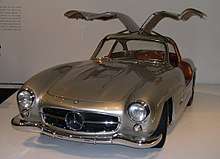
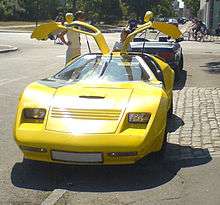
Road-legal cars
- AMT Piranha
- Aston Martin Valkyrie (2018)
- Atla (automobile)
- Autozam AZ-1
- Bradley GTII
- Bricklin SV-1
- Bristol Fighter
- Dare DZ
- De Tomaso Mangusta (engine compartment)
- DMC DeLorean
- Eagle SS
- Embeesea Charger
- Fiberfab Aztec 7
- Foers Ibex
- GP Talon
- Gumpert Apollo
- Gumpert Apollo Sport
- Hofstetter Turbo
- Innes Lee Scorpion K19
- Isdera Commendatore 112i
- Isdera Commendatore GT
- Isdera Imperator 108i
- Melkus RS 1000
- Melkus RS 2000
- Mercedes-Benz 300SL
- Mercedes-Benz 300SLR Uhlenhaut Coupe
- Mercedes-Benz SLS AMG – The SLS AMG is inspired from the 300SL
- Mercedes-Benz SLS AMG Electric Drive
- Mercedes-Benz SLS AMG GT and Mercedes-Benz SLS AMG GT Final Edition
- NSU Thurner RS
- Pagani Huayra
- Quant E
- Quant F
- Replicar Cursor
- RPB GT
- Siva S160 Spyder
- Suzuki Cara
- Tesla Model X – Conventional front doors, with rear falcon wing doors
Racing cars
- Bill Thomas Cheetah
- Chaparral 2D
- Chaparral 2F
- Howmet TX
- Lola T70 3B
- Lola T70 Mk3
- Mercedes-Benz 300SLR
- Mercedes-Benz SLS AMG GT3
- Mercedes-Benz SLS AMG GT3 45th Anniversary
- Nimrod Aston Martin
- Nissan GT-R LM Nismo
- Opel Astra V8 Coupe DTM
- Opel Astra Xtreme – A racing car based on the Opel Astra with front gullwing doors
- Peugeot 905
- Toyota GT-One
Concept cars
- Alfa Romeo 33.2
- Asardo 1500 AR-S
- Aston Martin Bulldog
- Aston Martin Valkyrie
- Bertone Birusa
- Buick Riviera Concept
- BMW Turbo
- BMW Z9 – Gullwing door on driver's side, with conventional door on passenger's side
- Citroën Tubik
- Daewoo Mya
- Ferrari Sergio
- Ford Corrida
- Ford Evos – Front gullwing doors, with rear gullwing doors
- Giugiaro Brivido
- Gumpert Tornante
- GM Ultralite
- Hyundai Nuvis
- Infiniti Triant
- Isdera Commendatore 112i
- Italdesign Giugiaro Clipper – Front butterfly doors, with rear gullwing doors
- Jiotto Caspita
- Kia KV7 – Conventional front doors, with rear gullwing doors
- Koenigsegg Quant
- Lincoln Navigator Concept
- Matra Laser
- Mazel Identity i1
- Mazda HR-X
- Mazda Ryuga
- Mazda RX-500 — Butterfly front doors, with gullwing doors over the engine compartment
- Mercedes-Benz AMG Vision Gran Turismo
- Mercedes-Benz C111
- Mercedes-Benz C112
- Mercedes-Benz F125
- Nissan Mixim
- Nissan NX-21 Concept
- Opel ECO Speedster
- Opel Monza
- Pininfarina Sergio
- Renault Mégane Coupe – A concept car based on the Renault Mégane with gullwing doors
- Renault Nepta
- Renault Talisman
- Rolls-Royce 101EX
- Subaru Hybrid Tourer
- Toyota Fine-X, Fine-T
- Toyota i-Road
- Toyota Concept-愛i Ride
- Ultima Mk1
- Vauxhall Monza
- Volvo C30 IPD SEMA
- Volvo Your Concept Car
Suicide doors
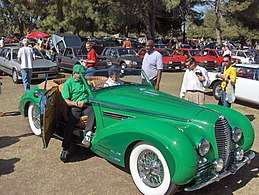
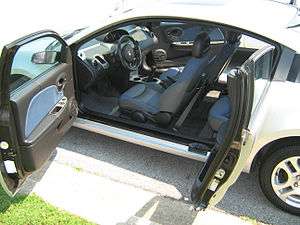
Models of automobiles that featured suicide doors (i.e., doors hinged at the rear) include most full-sized extended-cab pickup trucks (rear doors only), and some vehicles categorised:
- AC Petite (1953–1958) (Front door on 2-door saloons)
- Acura Precision Concept (2016) (Rear door)
- Adler Typ 10 2.5 Litre
- Alfa Romeo 8C
- Alfa Romeo Gloria (2013) (Rear door)
- Alfa Romeo Romeo 1 and 2
- Alta A200 (1968–1974) (Front door)
- AMC Cavalier (1965) (Rear door)
- Aston Martin Atom (1939/1944) (Front door)
- Austin 7 (1922–1939) (Front door on 2-door tourers, 2-door convertibles, 2-door saloons, 2-door coupes and 3-door vans)
- Austin FX4 taxi (1958–1997) (Rear door)
- Autobianchi Bianchina Trasformabile
- BAIC BJ100
- Bentley State Limousine
- BMW 331 (1949) (Front door)
- BMW 502 4-door sedans (1954–1964) (Rear door)
- BMW i3 (2013–present) (Conventional front doors, with suicide half-rear doors)
- BMW i3 Concept (2011) (Rear door)
- BMW Vision Future Luxury (2014) (Rear door)
- Borgward Hansa 2400 (1952–1959) (Front and rear doors)
- Borgward Hansa 2400 Pullmanlimousine (1953–1959) (Front door)
- Bugatti Type 46 (1929–1939) (Front door)
- Bugatti Type 57 (1934–1940) (Front door)
- Buick Roadmaster (Rear door on 1st generation), (front door on 2nd generation)
- Cadillac Ciel (2011) (Rear door)
- Cadillac Eldorado Brougham (1957–1958) (Rear door)
- Cadillac LaSalle (1955) (Rear door)
- Cadillac Series 65 (1937–1938) (Rear door on 4-door sedans)
- Carbon Motors E7 police car (2008–2013) (Rear door)
- Carbon Motors TX7 police SUV (2008–2013) (Rear door)
- Chevrolet Biscayne (1955) (Rear door)
- Chevrolet Greenbrier
- Chevrolet Master 2-door sedans (1935) (Front door)
- Chevrolet Master Deluxe 2-door sedans (1935) (Front door)
- Chrysler Airflow 4-door sedans (1934–1937) (Rear door)
- Chrysler Akino (2005) (Rear door)
- Chrysler Cirrus Concept (1992) (Rear door)
- Chrysler Imperial Concept (2006) (Rear door)
- Chrysler Royal (1933–1950) (Rear door on 4-door sedans)
- Chrysler Windsor 4-door sedan (1946–1948) (Rear door)
- Citroën 2CV (1948–1964) (Front door)
- Citroën Activa (Rear door)
- Citroën C3 Lumiere (1998) (Rear door)
- Citroën C-SportLounge (2005) (Rear door)
- Citroën C6 Lignage (1999) (Rear door)
- Citroën H Van
- Citroën Hypnos (2008) (Rear door)
- Citroën Metropolis (2010) (Rear door)
- Citroën Revolte (2009) (Conventional front doors, with suicide half-rear doors)
- Citroën Traction Avant (1934–1957) (Front door on 4-door sedans, 2-door sedans, 2-door convertibles and 5-door hatchbacks)
- Citroën Xanae (1994) (Rear door)
- Dacia Duster Concept (2009) (Rear door)
- Daihatsu Deca Deca (2009) (Rear door)
- Daihatsu Deca Deca (2013) (Conventional front doors, with suicide half-rear doors)
- Daihatsu FX (2015) (Rear door)
- Daihatsu Hijet (1964–1968) (Front door on vans and pickup trucks)
- Daihatsu Hinata (2015) (Rear door)
- Dannenhauer & Stauss Cabriolet (1951–1957)(Front door)
- Datsun Model 16 (1937–1938) (Front door)
- Delahaye Type 135
- Denza EV (2012) (Rear door)
- DKW 1000 S (1958–1961) (Front door)
- DKW F7 (1937–1939) (Front door on 2-door sedans, 2-door cabriolet sedans and 2-door coupe cabriolets)
- DKW F8 (1939–1942) (Front door on 2-door sedans, 2-door cabriolets, 2-door sedan deliveries and 2-door flatbed trucks)
- Dodge Hornet (2006) (Rear door)
- Dodge Super 8 Hemi (2001) (Rear door)
- DS Divine (2014) (Butterfly front doors, with rear suicide doors)
- EMW 340 (1949–1955) (Front door)
- Fiat 500 (1957–1965) (Front door)
- Fiat 500 Spyder Bertone (1947) (Front door)
- Fiat 508C (1937–1953) (Rear door on 4-door sedans)
- Fiat 515 4-door sedans (1931–1935) (Rear door)
- Fiat 518 Ardita 4-door sedans (1933–1938) (Front door)
- Fiat 600 (1955–1969) (Front door)
- Fiat 600 Multipla
- Fiat 1100 (1953–1969) (Front door on 4-door sedans and 5-door estates)
- Fiat 1200 (1957–1961) (Front door on 4-door sedans)
- Fiat AR 55 Campagnola
- Fiat Topolino (1936–1955) (Front door)
- Ford 021C (1999) (Rear door)
- Ford 24.7 Wagon
- Ford F-150 SuperCab (1997–present) (Conventional front doors, with suicide half-rear doors)
- Ford F-250 Super Chief
- Ford Iosis X (2006) (Rear door)
- Ford Model U
- Ford Ranger SuperCab (2000–present) (Conventional front doors, with suicide half-rear doors)
- Ford Thunderbird 4-door sedans (1967–1971) (Rear door)
- Fuldamobil (1950–1969) (Front door on 2-door coupes and 2-door convertibles)
- GMC Granite (2010) (Rear door)
- Goggomobil 2-door sedans (1955) (Front door)
- Hino 4CV (1953–1961) (Front door on 4-door sedans and 4-door convertibles)
- Honda Element (2003–2011) (Conventional front doors, with suicide half-rear doors)
- Hongqi 77X (2015–present) (Rear door)
- Hongqi CA 72
- Hongqi CA 770/772/773
- Hongqi CA 7650
- Hongqi HQE
- Hyundai Blue-Will (2009) (Rear door)
- Hyundai Genesis HCD-14 (2013) (Rear door)
- Hyundai Portico
- Hyundai Santa Cruz (2015) (Conventional front doors, with suicide half-rear doors)
- Infiniti Etherea (2011) (Rear door)
- Infiniti Kuraza (2005) (Rear door)
- Infiniti Q80 Inspiration (2014) (Rear door)
- Invacar
- Isuzu GBX (2001) (Rear door)
- Italdesign Giugiaro Gea (2015) (Rear door)
- JAC SC-9 (2014) (Rear door)
- Jaguar B99 (2011) (Rear door)
- Jaguar Mark IV (1935–1949) (Front suicide doors, with rear suicide doors)
- Jaguar R-D6 (2003) (Conventional front doors, with suicide half-rear doors)
- Jowett Javelin (1947–1953) (Front door on 4-door sedans)
- Kia Cross GT (2013) (Rear door)
- Kia GT (2011) (Rear door)
- Kia KND-7 (2013) (Rear door)
- Kia Naimo (2012) (Conventional front doors, with suicide half-rear doors)
- Kia Novo (2015) (Rear door)
- Kia Optima Convertible Concept (2015) (Rear door)
- Kia Ray PHEV (2010) (Rear door)
- Kia Soul Concept (2008) (Rear door)
- Kia Telluride (2016) (Rear door)
- Kurogane Baby (1959–1961) (Front door on vans and pickup trucks)
- Lagonda 3-Litre (1953-1958) (Front door)
- Lancia Aprilia 4-door sedan (1937–1949) (Rear door)
- Lancia Ardea 4-door sedan (1939–1953) (Rear door)
- Lancia Aurelia 4-door sedan (1950–1958) (Rear door)
- Lancia Dialogos (1998) (Rear door)
- Lancia Florida I 4-door sedan (1955) (Rear door)
- Land Rover Discovery Vision Concept (2014) (Rear door)
- Lexus HPX (2003) (Rear door)
- Lincoln C Concept (2009) (Rear door)
- Lincoln Continental/Lincoln Continental police car (1961–1969)/(1961–1967) (Rear door on 4-door sedans, 4-door convertibles and police cars)
- Lincoln Continental Concept (2002) (Rear door)
- Lincoln MKS Concept (2006) (Rear door)
- Lincoln Navicross (2003) (Rear door)
- Lincoln-Zephyr (1936–1940) (Rear door on 4-door sedans and 4-door convertible sedans)
- Lloyd 300
- Lloyd 400
- Lloyd LT 600 Van
- Maybach Zeppelin (1928–1938) (Front door on 4-door sedans, 4-door convertibles and 2-door convertibles)
- Mazda BT-50 Freestyle Cab (2002–present) (Conventional front doors, with suicide half-rear doors)
- Mazda RX-8/Mazda RX-8 police car (2003–2011) (Conventional front doors, with suicide half-rear doors)
- Mazda RX-8 Concept (2001) (Conventional front doors, with suicide half-rear doors)
- Mazda Secret Hideout (2001) (Rear door)
- Mercedes-Benz 170
- Mercedes-Benz 220 (1951–1955) (Front door on 4-door sedans, 2-door coupes and 2-door cabriolet 'A's)
- Mercedes-Benz F700 (2008) (Rear door)
- Mercedes-Benz Vision G-Code (2014) (Conventional front doors, with suicide half-rear doors)
- Mercury Eight 4-door sedan/Mercury Eight police car (1938–1951) (Rear door)
- Mercury MC4 (1997) (Conventional front doors, with suicide half-rear doors)
- MG Icon (2012) (Conventional front doors, with suicide half-rear doors)
- MG TF and TF 1500 (1953–1955) (Front door)
- Mini Clubman (2008–2015) (Conventional front doors, with single suicide half-rear door)
- Mini Clubvan (2012) (Conventional front doors, with single suicide half-rear door)
- Mitsubishi eX Concept (2015) (Rear door)
- Mitsubishi Re-Model A (by West Coast Customs) (2017) (Rear door)
- Morris Eight (1935–1948) (Front door on 2-door sedans, 4-door sedans, 2-door convertibles and tourers)
- Nissan Ellure (2010) (Rear door)
- Nissan Gripz (2015) (Butterfly front doors, with suicide half-rear doors)
- Nissan Intima (2008) (Rear door)
- Nissan Prince Royal (1966–1967) (Rear door)
- Nissan Qashqai (2004) (Rear door)
- Nissan Qazana (2009) (Conventional front doors, with suicide half-rear doors)
- Nissan Sway (2015) (Rear door)
- Nissan Titan Extended Cab – Conventional front doors, with suicide half-rear doors
- Nissan Townpod (2010) (Conventional front doors, with suicide half-rear doors)
- Oldsmobile O4 (2001) (Conventional front doors, with suicide half-rear doors)
- Oldsmobile Recon (1999) (Rear door)
- Oldsmobile Series 60 (1938–1948) (Rear door on 4-door sedans)
- Opel Admiral 4-door saloon/4-door cabriolet (1937–1939) (Rear door)
- Opel Flextreme (2008) (Rear door)
- Opel Flextreme GT/E (2010) (Rear door)
- Opel Kapitän 4-door sedans (1938–1953) (Rear door)
- Opel Meriva (2010–2017) (Rear door)
- Opel Meriva Concept (2008) (Rear door)
- Packard One-Ten (1938–1942) (Rear door on 4-door sedans)
- Packard Super Eight (1939–1951) (Rear door on 4-door sedans)
- Panhard Dyna Junior
- Panhard Dyna X
- Panhard Dyna Z
- Peel P50
- Peugeot 202 (1938–1942) (Front door on 4-door sedans, 2-door cabriolets and 2-door fourgonettes)
- Peugeot 203 (1948–1960) (Front door on 4-door sedans, 5-door estates, 2-door cabriolets, 4-door cabriolets and 2-door coupes)
- Peugeot 301 (1932–1936) (Front door on 4-door sedans, 2-door coupes, 2-door cabriolets and 3-door vans)
- Peugeot 302
- Peugeot 402
- Peugeot 601
- Peugeot BB1 (2009) (Front door)
- Peugeot EX1 Concept (2010) (Front door)
- Peugeot Fractal (2016) (Front door)
- Peugeot SXC Concept (2011) (Rear door)
- Peugeot VLV
- Pininfarina Cambiano (2012) (Conventional front doors, with single suicide rear door)
- Pontiac Strato Streak (1954) (Rear door)
- Porsche 928 Study H50 (1987) (Conventional front doors, with suicide half-rear doors)
- Porsche Mission E (2015) (Rear door)
- Praga Piccolo Furgon
- Proton e-Luma (2014) (Conventional front doors, with suicide half-rear doors)
- Renault 4CV (1946–1961) (Front door on 4-door sedans and 4-door convertibles)
- Renault Celtaquatre 4-door sedan/2-door coupe/2-door cabriolet (1934–1938) (Front door)
- Renault Egeus (2005) (Rear door)
- Renault Eolab (2014) (Rear door)
- Renault Frendzy (2011) (Conventional front doors, with single suicide door and single sliding door)
- Renault Initiale Paris (2013) (Rear door)
- Renault Monaquatre 4-door sedan (1931–1936) (Rear door)
- Renault R-Space (2011) (Rear door)
- Renault Twin'Z (2013) (Rear door)
- Renault Vivastella 4-door sedan (1934–1939) (Front door)
- Riley RM (1945–1955) (Front door on 4-door sedans and 2-door convertibles)
- Rolls-Royce 200EX (2009) (Rear door)
- Rolls-Royce Dawn (2015–present) (Front door)
- Rolls-Royce Ghost (2010–present) (Rear door)
- Rolls-Royce Ghost EWB (2011–present) (Rear door)
- Rolls-Royce Phantom (2003–2017) (Rear door)
- Rolls-Royce Phantom (2018–present) (Rear door)
- Rolls-Royce Phantom Coupe (2008–2017) (Front door)
- Rolls-Royce Phantom Drophead Coupe (2007–2017) (Front door)
- Rolls-Royce Phantom EWB (2005–2017) (Rear door)
- Rolls-Royce Phantom I, II, III, IV, V and VI
- Rolls-Royce Silver Dawn (1949–1955) (Front door on 4-door sedans)
- Rolls-Royce Silver Wraith (1946–1958) (Rear door on 4-door sedans)
- Rolls-Royce Wraith (2013–present) (Front door)
- Rover P3 4-door sedan (1948–1949) (Front suicide doors, with rear suicide doors)
- Rover P3 4-door sports sedan (1948–1949) (Front suicide doors, with rear suicide doors)
- Rover P4 (1949–1964) (Rear door on 4-door sedans)
- Russo-Baltique Impression (2007) (Front door)
- Saab 92 (1949–1956) (Front door on 2-door coupes)
- Saab 93 (1956–1960) (Front door on 2-door coupes)
- Saturn Flextreme (2008) (Rear door)
- Saturn Ion Quad Coupe (2002–2007) (Conventional front doors, with suicide half-rear doors)
- Saturn SC (1999–2002) (Conventional front doors, with single suicide half-rear door)
- Scion t2B (2005) (Conventional front doors, with suicide half-rear doors)
- SEAT 600 and SEAT 600 D (1957–1970) (Front door on 2-door sedans)
- SEAT 800 (1963–1968) (Front door on 4-door sedans)
- Simca 6 (1947–1950) (Front door on 2-door coupes and 3-door vans)
- Simca 8 4-door sedan (1937–1951) (Rear door)
- Singer Hunter (1954–1956) (Rear door on 4-door sedans)
- Singer SM1500 (1948–1954) (Rear door on 4-door sedans)
- Škoda Superb 4-door sedan (1934–1949) (Front door)
- Škoda VOS 4-door sedan (1949–1952) (Front door)
- Spyker D12 Peking-to-Paris (2006) (Rear door)
- Studebaker Champion 4-door sedans (1947–1952) (Rear door)
- Subaru 360 (1958–1971) (Front door on 2-door sedans and 2-door convertibles)
- Subaru B11S (2003) (Conventional front doors, with suicide half-rear doors)
- Subaru Sambar (1961–1966) (Front door on vans and pickup trucks)
- Sunbeam-Talbot 90 (1948–1954) (Rear door on 4-door sedans)
- Sunbeam-Talbot Ten 4-door sedan (1938–1948) (Front suicide doors, with rear suicide doors)
- Suzuki Mom's Personal Wagon (2005) (Rear door)
- Suzulight FB/FBD (1961–1965) (Front door on 3-/4-door vans and 2-door pickup trucks)
- Ssangyong XIV-1 (2011) (Rear door)
- Tata Nexon (2014) (Conventional front doors, with suicide half-rear doors)
- Tatra 57 2-door coupes (1932–1949) (Front door)
- Tatra 600 (1947–1952) (Front door)
- Toyota AA 4-door sedans (1936–1943) (Rear door)
- Toyota A-BAT (2007) (Conventional front doors, with suicide half-rear doors)
- Toyota Century Royal
- Toyota Crown (1955–1962) (Rear door on 4-door sedans)
- Toyota FJ Cruiser (2006–2018) (Conventional front doors, with suicide half-rear doors)
- Toyota FT-SX (2005) (Rear door)
- Toyota Hybrid X (2007) (Rear door)
- Toyota ME.WE (2013) (Rear door)
- Toyota Origin (2000–2001) (Rear door)
- Toyota Tacoma
- Triumph Renown (front doors)
- Vauxhall 10-4 4-door sedan/2-door coupe/2-door tourer/2-door roadster (1937–1940) (Front door)
- Vauxhall Meriva (2010–2017) (Rear door)
- Venucia VOW (2015) (Rear door)
- Vespa 400 (1957–1961) (Front door)
- Volkswagen Concept A (2006) (Conventional front doors, with suicide half-rear doors)
- Volkswagen Nezza (2006) (Rear door)
- Volkswagen Transporter (T1) (1950–1967) (Conventional front doors, with single conventional half-rear door and single suicide half-rear door)
- Volkswagen Type 147 Kleinlieferwagen (1964–1974) (Front door on 2-door panel vans)
- Volvo Concept Universe (2011) (Rear door)
- Volvo Concept You (2011) (Rear door)
- Volvo PV 36 Carioca (1935–1938) (Front door on 4-door sedans)
- Volvo Venus Bilo (1933) (Rear door)
- W Motors Fenyr SuperSport (2017–present) (Front suicide swan doors)
- W Motors Lykan HyperSport (2013–2017) (Front suicide swan doors)
- Wanderer W22
- Wanderer W24
- Zastava 750 (1955–1969) (Front door)
- ZAZ-965 Zaporozhets (1960–1969) (Front door)
Canopy doors
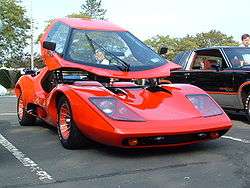
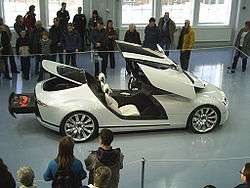
- AMC Amitron Concept (Side and windows with roof pivot back on counterbalanced hinges, clamshell-style)[1]
- Audi Avatar Concept
- Audi Urban Concept (Rearward sliding canopy that slides backward)
- Ed Roth's Beatnik Bandit "kustom" show car
- Bond Bug
- Bugatti Aerolithe
- Buick Wildcat Concept –
- Chrysler Turboflite (Glass canopy, hinge on rear)
- Citroën Osée
- Daihatsu UFE-III
- Dodge Charger III
- Ferrari Modulo
- FMR Tg500 (Aircraft-style canopy, hinge on right side)
- General Motors EN-V (Suicide-canopy, hinge on rear)
- Holden Hurricane
- Ikenga GT concept
- Isetta
- Isuzu COA
- Italdesign Quaranta
- Lamborghini Egoista
- Lamborghini Terzo Millennio
- Lancia Stratos Zero concept car[2]
- Loremo (Large bottom-hinged front canopy)
- Maserati Birdcage 75th – Extended canopy door, front 2/3 of the top of the car lifts up and moves forward)
- Messerschmitt Kabinenroller (Aircraft-style canopy, hinge on right side)
- Messerschmitt KR175 and Messerschmitt KR200 (Aircraft-style canopy, hinge on right side)
- Murray T25 and Murray T27
- Nissan 126X
- Nova (kit car)
- Opel CD
- Opel RAK e
- Paulin VR
- Pininfarina Modulo
- Renault Ondelios
- Renault Racoon
- Renault Trezor
- Saab Aero-X – (Canopy lifts upward and forward, sides move outward and forward)
- Smyk – Single front-mounted door was hinged at the bottom
- Sterling Nova
- Syrma IED – Rear hinged canopy
- Toyota EX-7 – Rear hinged canopy similar to Syrma IED
- Toyota Publica Sports (Rearward sliding canopy that slides backward)
- Tramontana (sports car)
- Volkswagen L1
- Volkswagen Nils
- Yamaha OX99-11
Swan doors
.jpg)
They open outward like either a conventional door or a suicide door, but hinge slightly upward as well for better ground clearance, includes some vehicles categorised:
- Alfa Romeo Disco Volante[3]
- Aston Martin CC100 Speedster
- Aston Martin DB9
- Aston Martin DB10
- Aston Martin DBS V12
- Aston Martin DBX
- Aston Martin DP-100
- Aston Martin Lagonda SUV
- Aston Martin One-77
- Aston Martin Rapide
- Aston Martin Rapide S
- Aston Martin Rapide Jet
- Aston Martin Rapide Bertone Jet 2+2
- Aston Martin V8 Vantage
- Aston Martin Vantage
- Aston Martin Vanquish
- Aston Martin Virage
- Aston Martin Vulcan
- Audi RSQ – Suicide-swan front doors
- Bentley EXP 10 Speed 6 Concept
- Bentley EXP 12 Speed 6e Concept
- Bertone Nuccio
- Chevrolet Corvette Stingray
- Fenyr SuperSport – Suicide-swan front doors
- GTA Spano (first generation only)
- Hennessey Venom GT
- Honda HSC
- Hyundai i-Oniq
- Jaguar C-X75
- Kia Pop
- Lagonda Taraf
- Lamborghini Asterion
- Lumeneo SMERA
- Lotus M250
- Lykan HyperSport – Suicide-swan front doors
- Marussia B2
- Mazzanti Evantra – Suicide-swan front doors similar to the Lykan HyperSport with panels extend to the roof from the top (similar to the Ford GT40)
- Mercedes-Benz F400 Carving
- Nissan Blade Glider
- Nissan Urge
- Pagani Huayra Roadster
- Peugeot HX1 Concept – Conventional-swan front doors, with suicide-swan rear doors
- Smart Forjeremy – A city car based on the Smart Fortwo with swan doors
- Toyota FT-1
- Toyota NS4
- Vencer Sarthe
- Volvo 3CC
Dihedral Synchro-helix actuation doors
.jpg)
Dihedral doors are a type of doors found on most Koenigsegg cars, open by rotating 90° at the hinge.
Other door types
- AMC Pacer – Aircraft-style doors cut into roof on hinges with outward arc of the top for easier entry when door is partially open, rain gutters hidden in the roof cut outs, passenger door is four-inches (101 mm) longer than the driver's[4][5][6][7]
- BMW 600 – Left-side-mounted front door
- Chevrolet Testudo – Canopy hinged at the front
- Chrysler ME Four-Twelve – Conventional front doors, but no door handles
- FMR Tg500 – Aircraft-style canopy doors, hinge on right side
- Ford GT (first generation), Ford GT40 and Ford GT90 – Conventional front-hinged doors that have panels extended to the roof of the car (also called aircraft doors)
- Hudson Italia – Doors cut 14 inches (356 mm) into the roof (also called aircraft doors)[8][9]
- Hyundai Veloster – Driver side of the car has one coupe-sized door, but the passenger side has two smaller, sedan-sized doors for front and rear occupants[10]
- Lincoln Futura – Glass roof canopy hinged at the rear
- Lincoln Mark VIII Concept – Doors "rolled" into underbody of frame (also called disappearing doors)[11]
- Messerschmitt Kabinenroller – Aircraft-style canopy doors, hinge on right side
- Mitsuoka MC-1 – Plastic doors that can be removed when opened
- Peel Manxcar – Suicide rear-hinged doors that open until it touches the body of the car
- Peel Trident – Flip-top door that opens like a canopy
- Smart Crossblade – Minimal "sword-like" door
- Suzuki CV1 – One single door in the car's fiberglass body
- Suzuki Pixy + SSC – The SSC has its doors hinged at both front and rear of the car, but the Pixy has a glass roof canopy hinged at the rear
- Tata Magic Iris – All three doors are conventional doors, 2 doors on the passenger's side and 1 door on the driver's side
- Toyota i-Unit – Glass roof canopy hinged at the rear
- TVR Tuscan Speed Six – Conventional front doors, but door handles are in button form under the side mirrors
- Zündapp Janus – Front- and rear-mounted side-hinged doors
Sliding doors
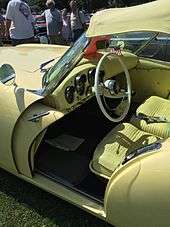
Sliding doors are common on minivans, leisure activity vehicles, light commercial vehicles and minibuses. A few passenger cars have notably also been equipped with sliding doors, such as the Peugeot 1007, the Suzuki Alto Slide Slim, the BMW Z1 and the 1954 Kaiser Darrin. Many concept cars use the design as well
Concept cars
- Bertone Ramarro–forward sliding doors
- Chrysler Portal–front doors slide forward, rear doors slide rearward
- Honda Vision XS-1–a single sliding door on each side for both the front and rear seats
- Lincoln Mark VIII Rolling door concept–doors slid downwards and disappeared into the bodywork
- Renault Scenic Concept–front doors slide forward, rear doors slide rearward
- Toyota Fine-Comfort Ride Concept–rear doors
- Toyota Kikai Concept
- Volkswagen BUDD-e–rear doors
- Volkswagen I.D.–rear doors
- Volkswagen I.D. Buzz–rear doors
- Volkswagen I.D. Crozz–rear doors
No doors
Some cars – generally those of a very open design – have no doors at all.
- Adamastor P003RL
- Allard Clipper
- Ariel Atom
- Bond Minicar
- Brütsch Mopetta
- Goggomobil Dart
- Myers Manx classic "dune buggy"
- Mini Moke
- Steyr-Puch Haflinger (convertible)
- Volkswagen Schwimmwagen
- Zenos E10
References
- "For Your Information". Car and Driver. 13: 80. 1967. Retrieved 2 November 2015.
- "Lancia Stratos Prototipo". videodigitalpixel. youtube.com. Retrieved 22 October 2012.
- "Photograph". sphotos-e.ak.fbcdn.net. Archived from the original on 25 February 2014.
- "Test driving the new Honda and Pacer". Kiplinger's Personal Finance. 29 (7): 29–30. July 1975. Retrieved 28 February 2018.
- "Design Notes: 1975 AMC Pacer". GM Inside News. 28 January 2013. Retrieved 28 February 2018.
- Montgomery, Andrew (2003). Illustrated Directory of American Automobiles. Salamander Books. p. 311. ISBN 9781840655346. Retrieved 28 February 2018.
- Koch, Jeff (March 2012). "1975-'80 AMC Pacer: The Pacer pointed the way toward modern car-design priorities". Hemmings Motor News. Retrieved 28 February 2018.
- Lyons, Dan (2005). Cars of the Fantastic '50s. Krause Publications. pp. 58–61. ISBN 9780873499262. Retrieved 28 February 2018.
- Vance, Bill (29 January 2010). "Motoring Memories: Hudson Italia, 1954". Autos Canada. Retrieved 28 February 2018.
- "Hyundai Veloster". Retrieved 17 February 2019.
- Massy, Kevin (18 July 2007). "Entrancing: Lincoln's disappearing-door concept". cnet. Retrieved 28 February 2018.